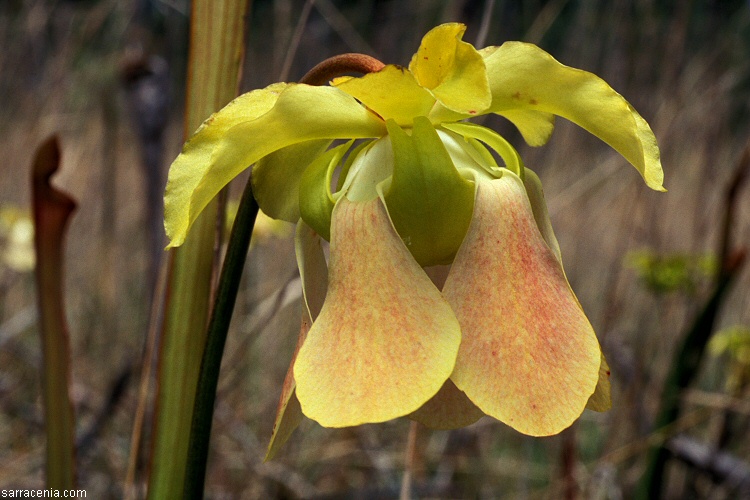
Pink flowers:
Intriguing, eh? Some of the plants--only a few--had flowers with some
red pigmentation in the petals, instead of the cream or yellow typical for this species.
So what gives? I think that these plants probably are telling us that somewhere in their past, a crossing occurred
between Sarracenia alata and a red-flowered plant. In this part of the USA, the almost certain culprit would be
Sarracenia psittacina. Sarracenia purpurea and Sarracenia leucophylla could both be
argued as long-shot candidates, but the closest specimens of these plants are a great many bee's-flights away, so such
a theory would also have to explain what happened to those plants.
The pitchers on this plant were still extremely juvenile, and the dried pitchers from the previous year were severely
decomposed. Even so, they did not exhibit any features that suggested hybridization with Sarracenia psittacina.
I bet the hybridization event is carried to the current day only in the abnormal flower coloration. Perhaps the pitchers
of hybrid plants confer less
reproductive fitness to the plants, and so the hybrid plants tend to die out over time.
On the other hand, it is possible
that poachers--always on the lookout for curiousities--collected all the obvious hybrids, and left only these
pink-flowered plants as shadows of the F1 plants that used to be here.
Or, I suppose, you could argue this was a novel mutation--hey, it could happen. If you want to discuss this more, contact
Carl Mazur or Jay Lechtman--they are the two who told me to keep my eyes open for pinkish flowers, and have thought
more about these plants than I have.
It was frustrating I could not find any Sarracenia psittacina. I looked and looked. This species can be very small
and hard to find, so maybe I was just looking in the wrong places. Also, it likes moister
conditions--perhaps the land had changed character
over the years, and the moist spots dried up and taken the S. psittacina with them.
Oh, here's another photograph of the plants.